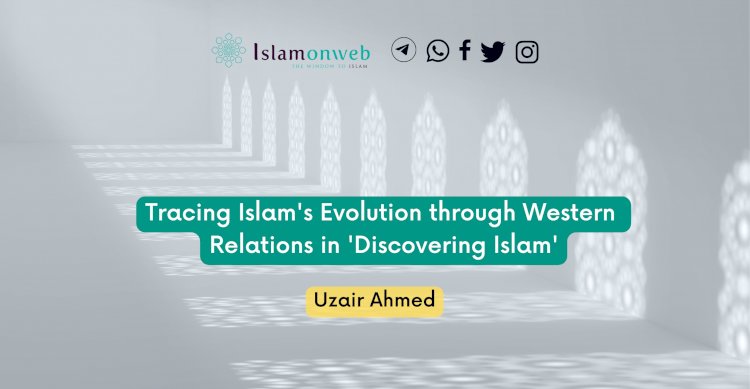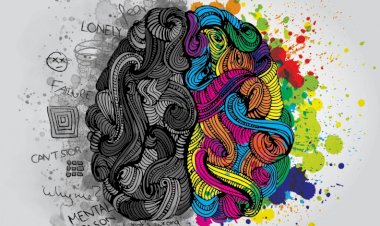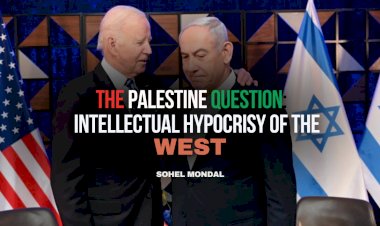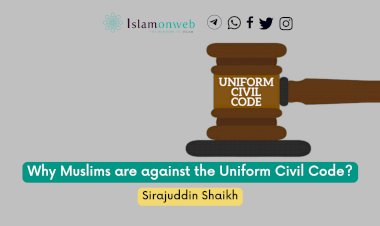Tracing Islam's Evolution through Western Relations in 'Discovering Islam'
Undoubtedly, it wouldn't be an overstatement to say that Islam is frequently depicted in a distorted manner as being aggressive and prone to violence. The images of Islam prevalent in the world are of brutality, fanaticism, hatred and disorder; Libyans killing policewomen, Palestinians hijacking passenger planes, Iranian seizing foreign embassies and Indonesian blowing up the temples in Java. Ayatollah Ruhollah Khomeini of Iran, Mohammed Gaddafi of Libya, Yasir Arfat of Egypt have become the key symbols of these images. In Walt Disney's roster of antagonists, we find names like Kho Maniac, Wacky Kaddafi, and Yucky Arafat within the realm of American animated filmmaking. Ironically, a contrasting reality emerges as we observe a depiction of a vulnerable and marginalized Muslim community in certain nations, such as India. To be a Muslim in India has become synonymous with being silent and voiceless. Dr. Akbar Salahuddin Ahmed, a Pakistani-American scholar, anthropologist, and diplomat, delineates two primary factors responsible for the propagation of disparaging and harmful portrayals of Islam:
- Lack of understanding of Islam among Europeans, liberals, humanists, Jews, Hindus and so on.
- The inability of Muslims to effectively articulate their perspective.
The author writes about the revival of Islam, saying it was always reviving after its decline and always being re-discovered after being neglected. But the Western perception of the revivalism, re-discovery or resurgence of Islam is quite different. The West links Islam with Arab oil, PLO guerrillas (Palestine Liberation Organisation), Imam Khomeini, ISIS and Jihadist terrorism. What makes the author stand out is his ability to show the true nature of Islam as it really is, and also how it's seen from a Western point of view. By the title "Making sense of Muslim history and Society" S. Ahmed chronologically explores the evolution of Islam, tracing its origins from the early era of the Prophet Muhammad's ﷺ life and his four closest companions, all the way to contemporary Western Muslim and South Asian Muslim communities. This historical journey not only provides a meaningful narrative for Muslim believers but also holds relevance for the global population as a whole.
The Islamic Golden Age
In certain ways, Muslims are the same everywhere and yet their societies are different. Islam will persist in influencing every facet of life within Muslim societies, encompassing attire, cuisine, and conduct. When Islam entered the African continent it adapted the Africanised version of Islam, as same as embraced the Asianization of Islam. One is bound to conclude that there is not one Islam but many Islams. It is a fact acknowledged by all that Umayyads of Damascus, Abbasids of Baghdad, Andalusian Caliphate of Cordoba and Emirates of Granada, and Kings of Delhi Sultanate and Mughal empire re-shaped, re-organized and re-oriented a new world order of Muslim society by establishing a glorious history in medieval age. The colleges in Andalusia were to provide a model for those at Oxford and Cambridge today. It produced the great minds and geniuses like Al-Rāzī, Al-Fārābī, Ibn Sīnā, and Al-Ghazali and their literatures and writings were the references to several modern religious and scientific explorations. It gave the birth to the masters of Islamic law; Abu Hanifa, Malik ibn Anas, Muhammed Al-Shafi and Ahmed ibn Hanbal. Within the discourse of the contributions of the Islamic world to science and education, it is important to remember that two Islamic scholars, Al Beruni and Ibn Khaldun, established the fundamental principles of two fields: Anthropology and Sociology, respectively.
Muslims in Colonial Period
Unlike India Muslim, minorities have lived in China and USSR with different cultures, national customs and traditions, integrating with their national identity. In China there are two groups of Muslim minorities: a) the group of merchants and travellers came to China in the 7th and 8th century. These Muslims integrated into Chinese society and adopted their surnames, foods and clothing. They are called a type of national community. b) The community comprises of the central Asian groups under Chinese imperial control in Uyghur autonomous region of Xingjian, which has been the subject of allegations against China for repression and genocide. In Russia, Muslim communities grew up because of the deep relationship between Russians and Mongols, as the great Mongol conquerors such as Chenghiz Khan and Taimur, invaded parts of Russia. Subsequently, the USSR collapsed, giving rise to what is now recognized as Central Asia, encompassing Uzbekistan, Tajikistan, and Kazakhstan.
Colonial rule proved to be an absolute catastrophe for Muslims. While it's possible to acknowledge the infrastructure development such as railways, telegraph, and law enforcement introduced by Europe, the profound toll of this colonial influence cannot be ignored or downplayed. Muslims continue to bear the weight of these repercussions. The colonial rule paralysed Muslim societies, congealed thought and froze their history and European notions of race and class entered and became part of Muslim society. Such notions of race and class fitted comfortably into African and Asian social structure which was recognized as the concept of divide and rule. As north Indian races; Pukhtuns and Punjabis were designated as the martial races and Bengalis were an inferior community. This myth finally laid to rest in 1971 when Bengalis got independence and Bangladesh came into being. Apart from this, during the colonial period of the British in India, some Muslim scholars who offered explanations, such as Sir Sayed Ahmed Khan and Sayed Amir Ali, were regarded as proponents of scientific rationalism. They created another type of Muslim leadership, drawing its inspiration from British culture, liberals, modern, rational and nationalist ideas jostled with Islamic teachings and transactions. In spite of their unparalleled contributions to modern Muslim society, they have faced allegations of aligning with the British rather than resisting them. They built the Muhammadan Oriental College, created Muhammadan laws and encouraged the Muslims to learn science and Quran simultaneously.
Contemporary Muslim Society
From the 19th century itself, Muslim society has been turned inside out. The history of the Arabian Peninsula unfolds in a pattern: an initial millennium of oblivion, followed by global recognition upon the advent of Islam in the Arab world; subsequently, another thousand years marked by obscurity and lack of knowledge, and now, in more recent times, the spotlight returns with the acquisition of oil resources. Now in the 21st century, Arabs have become masters of fabulous wealth and power. This time wealth would be available on their doorsteps. From the period of Muhammed Ibn Saud to today's King Salman, Arab have changed drastically within a very short period of time. Until the 1920s the capital city of Saudi Arabia, Riyadh, had no electricity, drainage and plumbing. In 1938, the revelation of oil took place. Following this discovery in Arabia, the nation transformed from being one of the most impoverished on the planet to becoming prosperous within the span of just a single generation. Now when excessive wealth is there in Muslim nations like Saudi Arabia, UAE, Qatar, and in fact, almost all gulf countries, the deprivation of power and privilege of influence thwart the progress towards the ideal. It is stated that Gulf countries like Saudi, UAE and Qatar became the home of millions of south Asians and jingle: “Dubai Chlo” is the equivalent of the expression “Westward ho!”
In the modern Muslim society, the most pertinent question about women empowerment is: Will their abilities be permitted to flourish, enabling them to contribute to the nation's progress, or will they be compelled into marriage and confined to their homes, overseeing household tasks? As we know the stereotype of female Orientals as chattels and playthings was formed, the position of women in Muslim society mirrors the destiny of Islam; when Islam is secure and confident so are its women; when Islam is threatened and under pressure so are its women. There are many well-established women Muslim social scientists like Fatimah Mernissi for Moroccans, Nawal El Sadawi for Egyptians, Shaila Hariri for Iranians, Sahiba Hafeez for Pakistanis, and Wazir Jehan for Malay women. They served the Muslim community as the social scientists, writers, activists and journalists. For instance, Nawal El Sadawi wrote the book, “The Hidden Face of Eve: Women in the Arab World” in 1982.
The topic of reconstruction of Muslim thought is excessively reinforced by contemporary Islamic scholars and intellectuals, such as Talal Asad, Hamza Alvi and Ismail Al Faruqi. They emphasized the importance of integrating modern Muslim scientists into the ulema. Ironically, these thinkers and writers often face limited recognition and encounter barriers that hinder their avenues of expression within their own societies. Consequently, persecuted scholars have sought refuge in the Western world, resulting in a loss for the Muslim community and a gain for the West. This situation brings to mind the words of Muhammed Abduh who observed: “I went to the West and saw Islam, but no Muslims; I got back to the East and saw Muslims, but not Islam.”
Conclusion
The United States seems to exert a mesmerizing influence over Muslims, whether they are perceived as allies (such as Egypt, Saudi Arabia, and Pakistan) or adversaries (as in the cases of Libya and Iran), thereby captivating Muslim society. Our awareness of Islamic virtues like piety, devotion, austerity, and kindness remains intact. In its ideal form, Islam advocates for ‘nurturing’ rather than ‘nature’. It is also incorrect to view contemporary Muslim society in isolation from its past; the past offers insight into the present circumstances.
References
Ahmed, K. (1976), Islam: Its Meaning and Message, Islamic council of Europe, London
Ahmed, A.S. (1983), Religion and Politics in Muslim Society: order and conflict in Pakistan, Cambridge University Press
Arberry, A.J. (1978), Aspects of Islamic Civilization, the University of Michigan Press
Al-Faruqi I. (1986), the cultural Atlas of Islam, Macmillan
Gellner, E. (1981), Muslim Society, Cambridge University Press
Haykel, M.H. (trans. I. al-faruqi) (1976), the life of Muhammed, Trust publications
Hitti, P.K. (1937), History of the Arabs, Macmillan, London
Khomeini, Imam (trans. H. Alger) (1981), Islam and Revolution: writings and declarations of Imam Khomeini, Mizan Press
Robinson, F. (1982), Atlas of the Islamic world since 1500, Phaidon Press
Schimmel, A.M. (9181), Mystical Dimensions of Islam, University of North Carolina Press
Shariatic, A. (trans. H. Alger), (1979), on the sociology of Islam, Mizan Press, Berkeley
Endnotes
BBC six-part television series; Living Islam and Islam today: A short introduction to the Muslim world
Discovery and revivalism of Islam
Great Muslim Empires: Ottomans, Saffavids and Mughals
The colonial impact on Muslim society and their engagement
Muslim societies in Saudi Arabia and South India
Ethnicity, women and refugees
The reconstruction of Muslim thought
America’s foes and friends
About the author
Uzair Ahmed is from Muzaffarnagar in Uttar Pradesh. He is a degree research scholar of the Dept. of Civilizational Studies at Darul Huda Islamic University.
Disclaimer
The views expressed in this article are the author’s own and do not necessarily mirror Islamonweb’s editorial stance.
























Leave A Comment